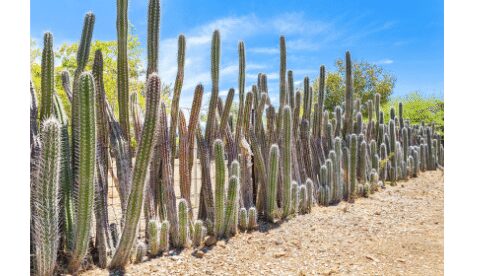Know in one minute about hedge cactus
|
Introduction
Hedge cactus (Cereus hildmannianus; Family Cactaceae) is a slow-growing, evergreen, tree-like cactus. This cactus is generally found in sandy and rocky soils. It is famous by the name “Queen of Night” because it blooms at night. This cactus fruit is consumed in different forms (fresh juices and cakes) due to its good flavor and antioxidant properties (1).
This plant is easy to care for and requires low maintenance for ornamental purposes. With age, these cacti form a tree-like woody structure, with branching occupying significant physical and visual space.
Common Name
Hildmann’s Cereus, Giant Club Cactus, Apple Cactus, Peruvian Apple Cactus, Peruvian Tree Cactus, Peruvian Torch, Column Cactus, Queen of the Night, Kaktus hildmannia, Mandacaru, Tuna, Tunam, Urumbeva, Night-blooming Cactus, Andes Organ Pipe, Spiny Tree Cactus.
Geographic Distribution
Hedge cactus is native in Southeast South America like Brazil, Bolivia, Paraguay, Uruguay, and Argentina (2).
Botanical description
1. Appearance
Hedge cactus is a tender, straight, multi-stemmed, generally spineless but sometimes golden or brown spine.
2. Height
This cactus can achieve a height of 20 – 50 feet and a width of 10 feet.
3. Stems
The stems are cylindrical, segmented, and blue-green to dull green. Each stem has four to six gray ribs and a very coarse texture.
4. Flower
This plant produces fragrant, large funnel-shaped white flowers when the plant is around 5 to 6 years old. Generally, flowers bloom during late spring and throughout the summer. These flowers open during nights and fade by until the early morning hours of the next day.
5. Fruits
The fruits are red to yellow in color and round pear-shaped. At maturity, they split open to expose this white, fleshy pulp. Also, embedded small, crunchy black seeds in them. This fruit is soft flavored like watermelon and is consumed by birds as well as people (3).
How to take care of hedge cactus
The propagation and care are very easy, this plant needs lots of sunshine and lots of fresh air.
1. Light
This plant needs direct light to grow properly and produce flowers so it is best for outdoors. For indoors, it can be placed near a sunny window. Since this plant is leaning towards the light source indoors, it is best to rotate it frequently.
2. Soil
Well-drained sandy soil is best, to avoid root rot of these plants.
3. Water
This plant requires water in a moderate amount when the top few inches of soil are dry. Also, allows the soil to dry out between watering.
4. Temperature
Hedge cactus plants can tolerate temperature 61-75°F (16°C-24°C).
5. Fertilizer
Apply a balanced 1/4th water-soluble fertilizer during the active growing season. Do not fertilize the plant during dormant or winter seasons.
6. Repotting
Repotting of the hedge cactus plants should be done every year. The best time of repotting is the beginning of spring and move the plant into a pot one size larger.
7. Pruning
Prune the string of pearls plants is necessary to maintain its size and keep branches strong. Cuttings can also be rooted simply by inserting the ends in the sand.
How to propagate hedge cactus
Hedge cactus can be easily propagated using stem cuttings and replant it in potting soil. Before replanting, wait for a few days to allow it to callus formation over the cut surface and then placed it on the soil to root.
This plant can also be grown from seed but its germination rates are usually a low and slow process.
Health benefits of hedge cactus
- This plant also contains antioxidants like phenolic compounds that help to treat various diseases (1).
- Hedge cactus contains a high amount of alkaloids which show a wonderful effect to treat patients with prostate and breast cancer (4).
- This cactus is not only useful as an ornamental plant but also nutritious for animals due to its high protein content (5).
- Mosquito repellent activity– Hedge cactus contains active ingredients that block the smell of humans. Thus the application of this cactus on the skin, mosquitoes cannot identify the human as its source of the meal (6).
Toxic to cat and dog
Hedge cactus plants are non-toxic to cats and dogs.
Q&A
How much sun does a hedge cactus need?
This plant requires full bright sunlight.
When to water a hedge cactus?
Hedge cactus stores the water in their leaves so this plant only needs water at a moderate level. Keep watering only when the top of the soil is dry. Never sit your plant in water or remove excess water because it may cause rotting of roots and stems.
What type of soil does it need?
This plant prefers sandy, porous soil which drains quickly and helps to prevent moisture from rotting the roots.
